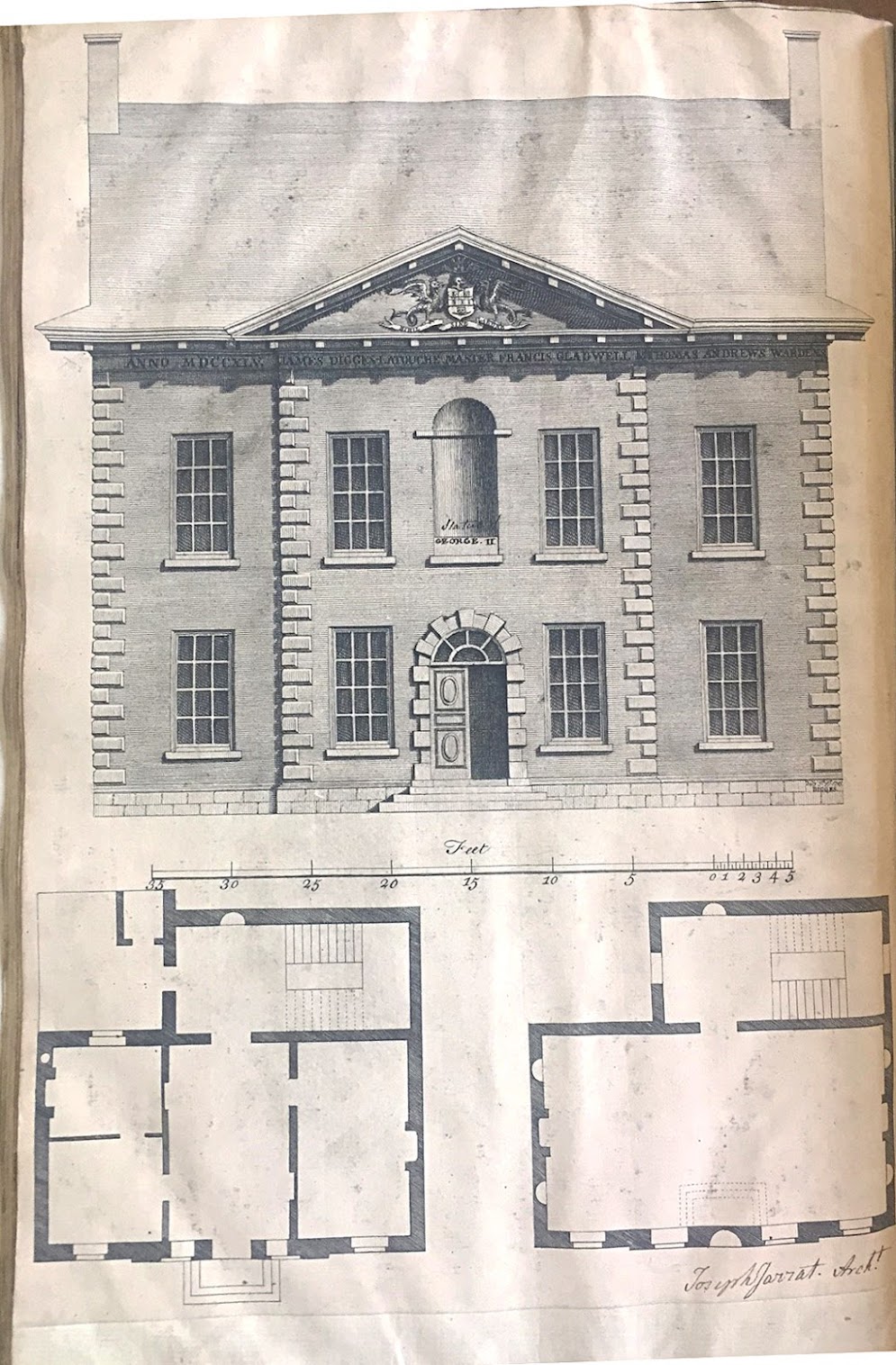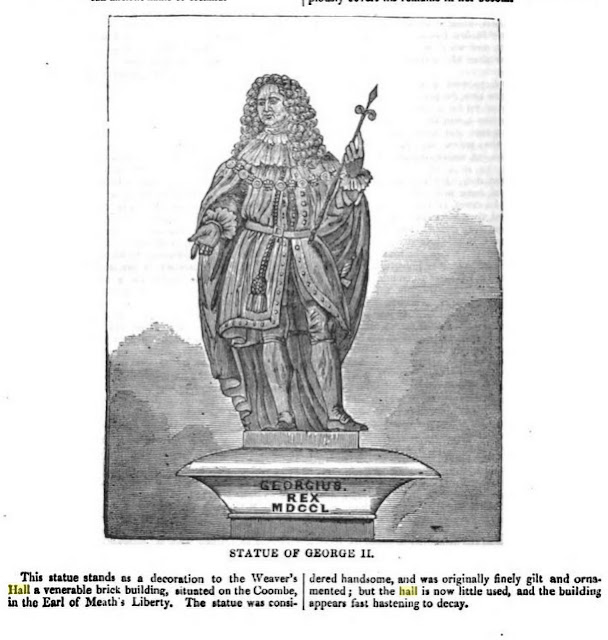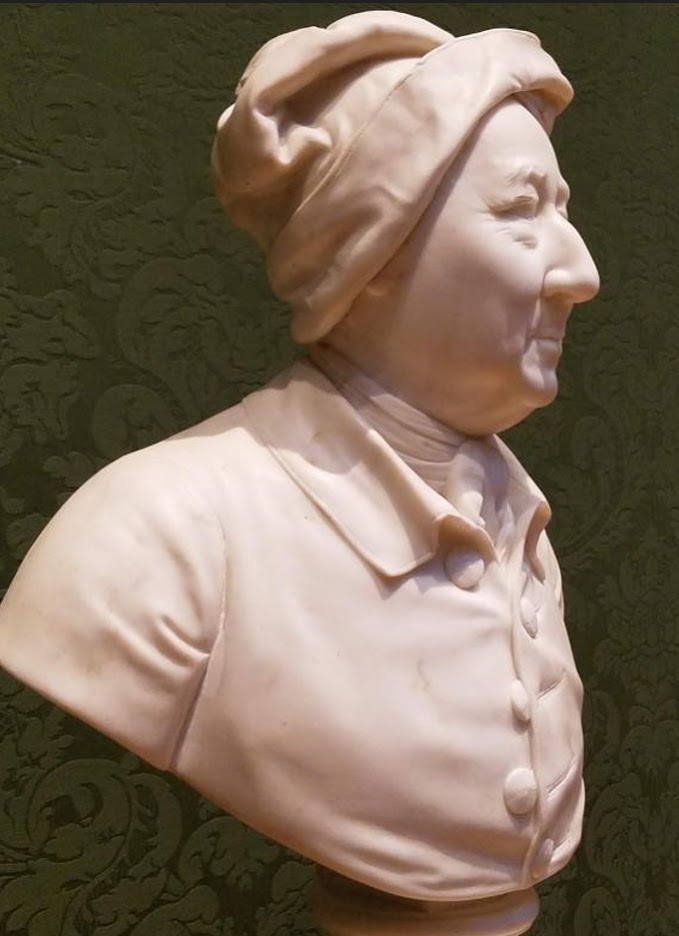Statue of George II and Weavers Hall, Dublin.
The Statue of George II and Weavers Hall, Dublin.
George II.
In Garter Robes
1750.
Attributed variously to John van Nost III (most likely) but possibly by Benjamin Rackstrow (doubtful).
...................
Benjamin.Rackstrow. Sculptor of
Exhibited at the Free Society .
169. A busto of the Marquis of Granby; large as life.
170 Ditto of Mr. Frye.
171. Ditto of a doctor of laws.
17.2 A figure of a gentleman, sitting; as large as life.
..................................
Weavers' Hall was a guildhall at 14 The Coombe, Dublin,
Ireland, which housed the Guild of Weavers (sometimes called the Guild of St
Philip and St James or the Guild of the Blessed Virgin Mary), one of the 25
Guilds of the City of Dublin. The building was constructed in 1745 to a design
by architect Joseph Jarratt to replace an earlier nearby weavers' guildhall in
the Lower Coombe which was built in 1681–2 and was located in what was
originally the Earl of Meath's Liberty.The building was demolished in
1965.
Jarrett designed the La Touche Bank in Cork Hill, Dublin.
The principal room on the first floor is 50' x 21'
The figure of George, holding shuttles and other implements
relating to the weaving trade, was removed and destroyed in November 1937 - it
was feared by the owners of the building that the IRA might attempt to blow it
up.
The Irish Times (17 November 1937) covered the story as
follows:
STATUE OF KING HACKED TO PIECES
“BETTER TO HAVE IT BLOWN UP”
What is described as “the last British King in the City of
Dublin” was beheaded in Dublin yesterday morning. Immediately afterwards men
set about the task of hacking off his legs and arms. This was the fate which
met the bronze statue of King George II, which has stood over the entrance of
the Weavers’ Hall, in the Coombe, since 1750, and the reason is that the
present owners of the premises, Messrs S. Fine and Co., Ltd., thought it better
to have the statue peacefully removed than to have it blown up.
An Irish Times reporter was told that it had been necessary
to dismember the statue in order to take it down without damaging the face of
the building. It was fitted into the front of the house with iron stays, and to
have removed it en bloc would have defaced the masonry. Some idea of the weight
of the statue may be gathered from the fact that the head alone weighs almost
50lb.
Although described as bronze I suspect it was actually made
of lead and originally gilded
This is probably rather disingenuous - it was probably much
easier to hack it apart and then sell it for scrap rather than to hire a crane
and remove it carefully - a great loss..
Fine and Company were house furnishers but a watercolour by
Flora Mitchell painted in the 1950's shows a very down at heel building. There
are photographs of it in its final stages of disintegration before it was
demolished in the Irish Architectural Archive on Merrion Square, Dublin which I
publish below.
Weavers Hall itself was finally demolished in 1965.
During the seventeenth century a number of French Huguenot
weavers arrived in Dublin. They settled manly in the Liberties area of Dublin,
west of St. Patrick’s Cathedral, where they became part of the existing weaving
fraternity. Many of them were experienced silk weavers and their expertise
contributed to the establishment of a thriving silk and poplin industry.
A weavers’ hall had been built by the Guild in the Lower
Coombe in 1682 and by 1745, when the building of a new hall was required, it
was a Huguenot, David Digges La Touche, who advanced the £200 needed. The main
room of the new hall is described as being fifty-six feet long by twenty-one
feet wide, wainscoted, and hung with portraits of kings and notabilities, and
included a tapestry portrait of King George II, woven by John van Beaver (see
below).
Image below courtesy South
Dublin Libraries.
Design for the chimneypiece illustrated above from the Joseph Jarratt scrapbook.
Another more austere Chimneypiece design from the Joseph Jarratt scrapbook.
Inscribed Joseph Jarrett.
Courtesy Irish Architectural Archive.
Possibly representing a chimneypiece from the ground floor of the Weavers Hall.
Photographed by the author 6 October 2016.
..........................
It is possible that the interior fittings of the Weavers
Hall were saved.
The Irish Archive files suggest that some of them were moved
and were in The Cottage, Kanturk in 1987. A Google search could find no mention
of it.
This image from The Dublin Penny Journal, vol. 4 - 12
December, 1835.
Sizes 66 x 52.1 x 27.9 cm.
Patrick Cunningham was taken on as an apprentice by John van Nost in
May 1750.
John van Nost III is first mentioned in the Royal Dublin Society's papers
in 1749 when he is described as living in Jervis Street where he exhibited models in
plaster.
Van Nost made a number of return visits to London: these included
one in 1753 or 1754 to hold sittings with King George II for the equestrian
statue in St Stephen's Green, another in 1763, when he had a London address 'At
Mr Clarke's, St Martin's-lane, opposite May's-buildings',
In 1763 he was listed in Mortimer’s Universal Director ‘at
Mr Clarke’s, St Martin’s-lane, opposite May’s-buildings’ (p 28; Rate-Books
1763, Cleansing Street Rates, F6007).
J T Smith later
recollected that Nost had lived at 104, St Martin’s Lane, in a large house, once
inhabited and decorated by King George I’s sergeant painter, Sir James
Thornhill.
In 1779 the sculptor was residing at No. 21 Mecklenburgh Street, Dublin and in that year, on 19th October, his statue of "Hugh Lawton," Mayor of Cork, 1776, was erected in Cork.
In the following year he returned to London, where he stayed four years on account of ill-health.
Returning to Dublin he there passed the remainder of his life, dying in
Mecklenburgh Street in 1787.
David Digges la Touche.
John van Nost III.
Huntington Library Art Collection.
There are several other 18th
Century busts in in the Huntington Collection.
Oliver Cromwell -
Michael Rysbrack.
John Hamden - Michael Rysbrack.
Sir Peter Warren - L.F. Roubiliac.
Handel Plaster - Roubiliac.
Philip Stanhope 4th Earl Chesterfield - Scheemakers.
The tapestry of George II woven by John van Beaver, which hung in the Weavers’ Hall.
It is now in the Metropolitan Museum of New York.








.jpg)





















No comments:
Post a Comment